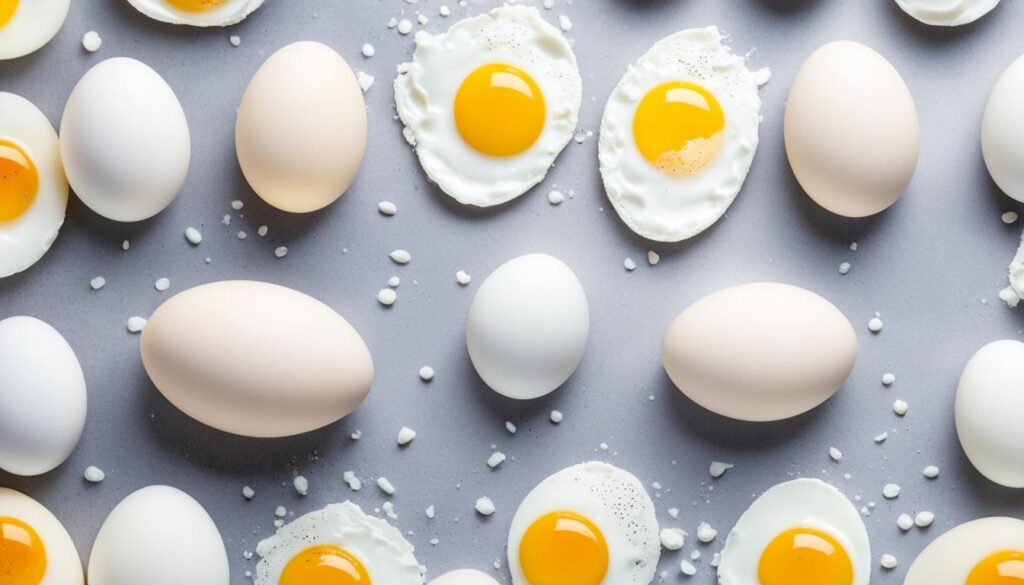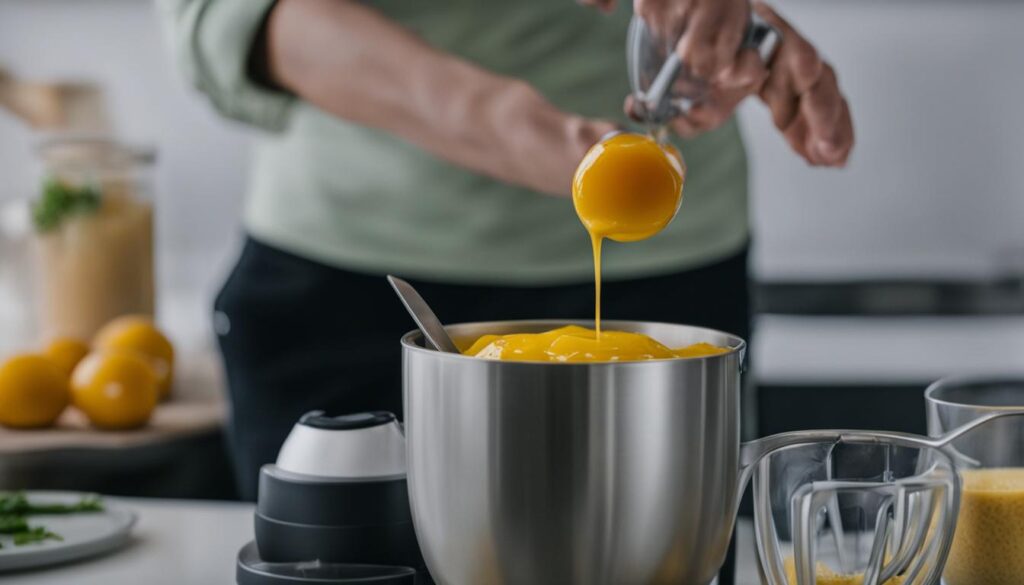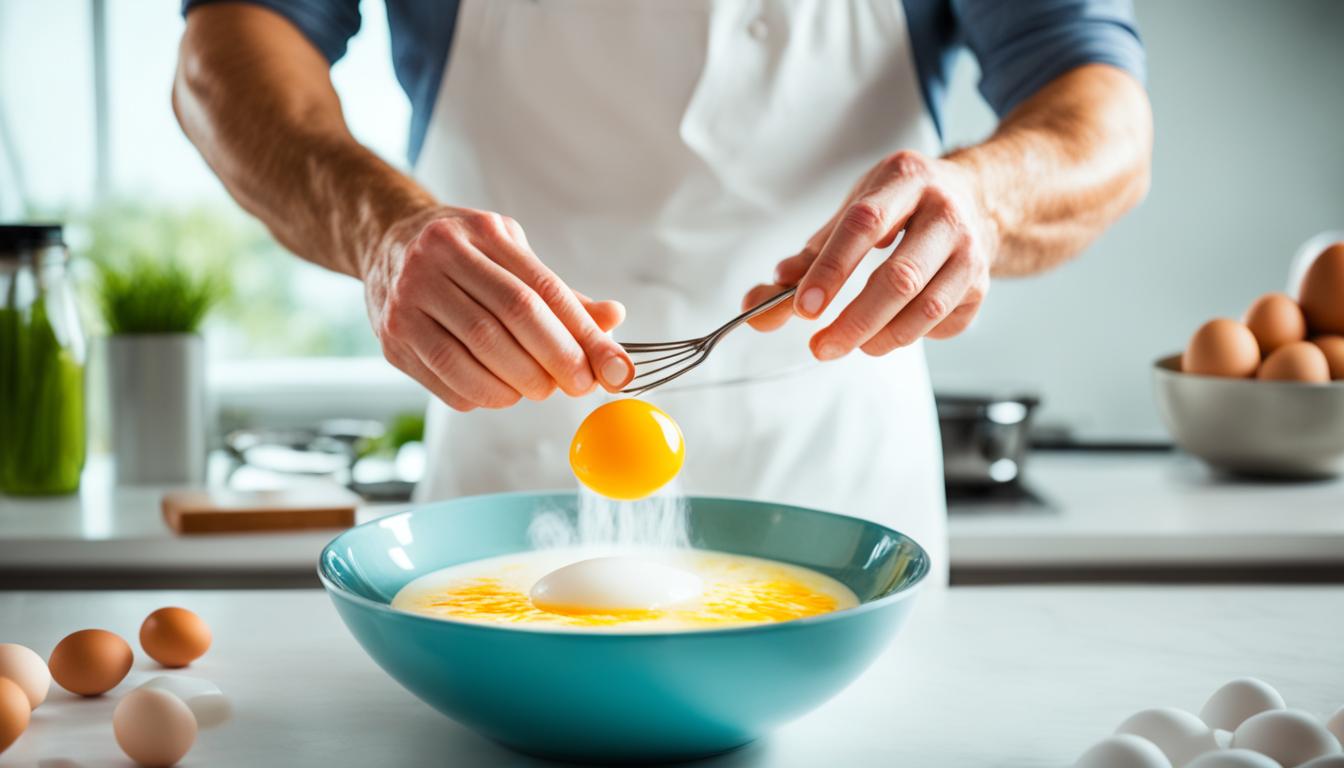Welcome to our guide on tempering eggs! In this article, we’ll explore the why, when, and how of tempering eggs, a culinary technique that can elevate your cooking and baking to new heights. Whether you’re a seasoned chef or a beginner in the kitchen, understanding the importance of tempering eggs is essential. So let’s dive in and learn more about this fascinating process.
Tempering eggs is a crucial technique in cooking and baking. It involves slowly introducing hot liquid to eggs to prevent them from scrambling and achieve smooth, creamy results. This process is essential for creating silky custards, thick sauces, and light and airy desserts. But why do we need to temper eggs? When is the right time to temper eggs? And how can we do it perfectly? We’ll answer all of these questions and more in the sections ahead.
The science behind tempering eggs is fascinating. Eggs contain proteins that react to heat and agitation, which can result in rubbery or curdled textures if not properly tempered. By diluting the eggs with liquids and gradually introducing heat, we can ensure a perfect protein matrix that yields smooth and creamy dishes. This scientific understanding is key to mastering the art of tempering eggs.
So, when should we temper eggs? Tempering is necessary when incorporating eggs into recipes that involve adding them to hot liquid. This prevents eggs from curdling and ensures a smooth texture. However, if the recipe doesn’t require preheating the liquid phase, tempering may not be necessary. In these cases, eggs can be combined with cold liquid and cooked gradually to achieve the desired consistency.
Now that we understand the importance of tempering eggs and when to do it, let’s explore the different methods of tempering. Traditionally, eggs are tempered by gradually whisking hot liquid into them while whisking vigorously. This method requires skill and attention to prevent curdling. Alternatively, the blender method allows for slow addition of hot liquid to the eggs using a blender or immersion blender, offering effective dilution without the risk of curdling. Choose the method that best suits your preferences and the recipe at hand.
Tempering eggs successfully requires a few key tips. Ensure you have a stable base for whisking, such as a folded kitchen towel, to prevent any slips or spills. Whisk the eggs while gradually adding hot liquid in a thin stream, allowing for dilution and gradual warming. Always check the mixture’s temperature before incorporating it back into the pot or pan. Constant whisking and properly controlling the temperature are vital for achieving a smooth and silky final product.
Culinary applications of tempered eggs are extensive. They are crucial in creating creamy custards, luxurious sauces, and stable soups. Tempering eggs is a fundamental technique in dishes like crème brûlée, hollandaise sauce, and avgolemono soup. With tempered eggs, you can explore a wide range of delicious desserts and savory delights.
Now that you understand the significance of tempering eggs and how to do it perfectly, it’s time to put your skills to the test. Embrace the culinary adventure of experimenting with tempering eggs in recipes and different cooking techniques. With practice and exploration, you’ll unlock the full potential of this valuable culinary skill, creating dishes that impress and delight.
The Science Behind Tempering Eggs
Eggs are a staple ingredient in many recipes, adding texture and binding properties. Understanding the science behind tempering eggs can help you create the perfect consistency and avoid any undesirable outcomes. When eggs are subjected to heat or agitation, the tightly coiled proteins inside start to unravel and form a mesh network. This protein matrix is responsible for the firm texture of cooked eggs.
However, if eggs are exposed to excessive heat or agitation, the proteins tighten and expel liquid. This can result in rubbery eggs or curdled mixtures that are far from appetizing. To prevent this, dilution is crucial. By diluting the eggs with liquids like milk, cream, sugar, or starch, the proteins are spread apart, reducing the likelihood of clumping together.
Gradual heat is equally important when tempering eggs. By introducing the eggs to heat gradually, you allow the proteins to accept the heat without tightening too much. This gradual increase in temperature, combined with dilution, ensures the formation of a perfect protein matrix, resulting in smooth and creamy dishes.

The Protein Matrix
The protein matrix formed during tempering is what prevents eggs from becoming rubbery or curdling. This protein matrix provides structural support and stability to the final dish, giving it a smooth and pleasing texture. Dilution with other ingredients helps to evenly distribute the protein molecules, minimizing clumping and ensuring a consistent texture throughout.
By understanding the science behind tempering eggs, you can confidently incorporate this technique into your cooking. Whether you’re making custards, sauces, or desserts, achieving the perfect protein matrix will elevate the taste and texture of your dishes.
When to Temper Eggs
Tempering eggs is essential when incorporating them into recipes with hot liquid. By following this technique, you can prevent the eggs from curdling and achieve a smooth and creamy texture in your dishes. This process is particularly important in egg-thickened dishes such as custards, soups, and sauces that require eggs to be added to hot liquid.
When preparing recipes that involve preheating the liquid phase, tempering is crucial. The gradual addition of hot liquid to the eggs allows them to slowly adjust to the temperature, preventing curdling and resulting in a silky texture. This method is commonly used in custards like crème brûlée, where the eggs are added to a hot cream mixture.
However, in recipes that don’t require preheating the liquid phase, tempering may not be necessary. For example, if you’re making a cold salad dressing that calls for eggs, you can simply combine the eggs with cold liquids and whisk them together. As long as the eggs are gradually incorporated and cooked gently, they will blend seamlessly with the other ingredients.
How to Temper Eggs
When it comes to tempering eggs, there are different methods to choose from, depending on personal preference and the equipment available. Two popular methods are traditional tempering and the blender method.
Traditional Tempering
In traditional tempering, you gradually whisk hot liquid into the eggs while whisking vigorously. This method requires coordination and attention to prevent curdling. To ensure a smooth and creamy texture, it is important to add the hot liquid slowly and continuously whisk the mixture to evenly distribute the heat. This gradual incorporation of hot liquid allows the eggs to gradually adjust to the temperature, preventing them from scrambling.
The Blender Method
In the blender method, the hot liquid is slowly added to the eggs using a blender or immersion blender. The fast mixing action of the blender ensures effective dilution without the risk of curdling. This method is especially convenient for those who prefer a more hands-off approach or want to achieve a consistent and smooth mixture effortlessly.
Both traditional tempering and the blender method have their advantages and are widely used in different recipes. The choice between the two methods can depend on personal preference, the desired texture, and the specific recipe being prepared.
| Method | Advantages |
|---|---|
| Traditional Tempering | – Allows for precise control – Ideal for small quantities – Traditional technique |
| The Blender Method | – Convenient and efficient – Ensures thorough mixing – Consistent results |

The choice between traditional tempering and the blender method ultimately depends on personal preference and the specific needs of the recipe. Experimenting with both techniques can help you discover which method works best for you and your culinary creations.
Tips for Successful Tempering
To ensure successful tempering, it’s important to follow a few key tips. These include:
- Creating a stable base for whisking by using a folded kitchen towel to prevent the bowl from moving.
- Gradually adding hot liquid to the eggs in a thin, steady stream while whisking continuously.
- Diluting the eggs and warming them up gradually by adding the hot liquid in small increments.
- Checking the temperature of the mixture by touching it to ensure it reaches the desired level before incorporating it back into the pot or pan.
- Whisking constantly and scraping the sides and bottom of the pot to prevent any curdling.
- Maintaining the proper temperature throughout the tempering process.
By following these tips, you can achieve a smooth and silky final product when tempering eggs.
| Tip | Description |
|---|---|
| Stable base | Use a folded kitchen towel to keep the bowl in place while whisking. |
| Gradual addition | Add hot liquid to the eggs slowly in a thin stream to dilute and warm the eggs gradually. |
| Proper temperature | Check the temperature of the mixture before incorporating it back into the pot or pan. |
Common Culinary Applications of Tempered Eggs
Tempering eggs is a versatile technique used in various culinary applications. By incorporating tempered eggs into your recipes, you can elevate the flavors and textures of a wide range of dishes, from delicate custards to luscious ice creams, savory sauces, comforting soups, and delectable desserts. The art of tempering eggs opens up a world of possibilities in the kitchen, allowing you to create dishes that are rich, creamy, and perfectly balanced.
1. Creamy Custards
Tempered eggs are the secret to creating velvety-smooth custards like crème brûlée. By slowly adding hot liquid to the eggs while whisking continuously, you ensure a silky texture and prevent any curdling. The result is a custard that melts in your mouth, providing a delightful indulgence with every spoonful.
2. Luxurious Ice Creams
Ice cream lovers rejoice! Tempering eggs is an essential step in making homemade ice creams that rival those from your favorite artisanal creameries. The gradual addition of hot cream to the eggs creates a rich and creamy base, allowing for a smooth freeze and a decadent dessert experience.
3. Flavorful Sauces
Sauces like hollandaise or béarnaise rely on tempered eggs to achieve their luscious consistency. By gently incorporating warm melted butter into the eggs, you create a velvety smooth sauce that elevates any dish, from eggs Benedict to grilled asparagus and steak.
4. Comforting Soups
Tempering eggs plays a crucial role in giving soups a creamy and luxurious texture. In traditional Greek avgolemono soup, tempered eggs are combined with a flavorful broth and lemon juice, resulting in a deliciously tangy and velvety soup that warms the soul.
5. Decadent Desserts
When it comes to desserts, tempered eggs are a game-changer. They provide stability and a silky texture to classics like lemon curd, turning them into irresistible treats. The artful combination of tempered eggs with ingredients like sugar, butter, and citrus transforms desserts into indulgent delights.
By mastering the technique of tempering eggs, you unlock the potential to create a wide array of delectable dishes. Whether you’re a seasoned chef or an aspiring home cook, incorporating tempered eggs into your culinary repertoire will take your creations to new heights, bringing richness, smoothness, and unparalleled flavor to custards, ice creams, sauces, soups, and desserts.
| Culinary Application | Description |
|---|---|
| Custards | Delicate and silky desserts, usually baked or chilled, made with a custard base of tempered eggs, sugar, and cream. |
| Ice Creams | Creamy frozen desserts made by churning a mixture of tempered eggs, cream, sugar, and flavorings in an ice cream maker. |
| Sauces | Luxurious and flavorful accompaniments made with tempered eggs, butter, and other ingredients, often served with meat, fish, or vegetables. |
| Soups | Comforting and satisfying dishes where tempered eggs add creaminess and body, such as avgolemono, a traditional Greek lemon soup. |
| Desserts | Indulgent treats like lemon curd and other fruit-based delights that become velvety smooth and stable thanks to tempered eggs. |
Practice and Explore Tempering Eggs
Learning how to temper eggs is a valuable culinary skill that can elevate your cooking and baking. It requires practice and experimentation to understand the nuances of temperature control and the impact it has on the final outcome of your dishes. By mastering the art of tempering eggs, you’ll be able to create a wide range of delicious recipes that showcase the smooth and creamy results achieved through this technique.
One of the best ways to improve your culinary skill in tempering eggs is through experimentation. Try different recipes that call for tempered eggs and explore various cooking techniques. This will allow you to understand how different factors, such as the temperature of the hot liquid or the speed at which you incorporate it, can affect the end result.
As you gain confidence in tempering eggs, you’ll discover that it opens up a whole new world of possibilities in the kitchen. From custards and ice creams to sauces and soups, properly tempered eggs add richness, texture, and stability to a wide variety of dishes. So don’t be afraid to step outside your comfort zone and try something new!
Remember, practice makes perfect. The more you experiment with tempering eggs, the more you’ll develop your cooking techniques and hone your skills. So grab your whisk, gather your ingredients, and get ready to create culinary masterpieces that will impress your friends and family. With dedication and perseverance, you’ll become a pro at tempering eggs in no time.
